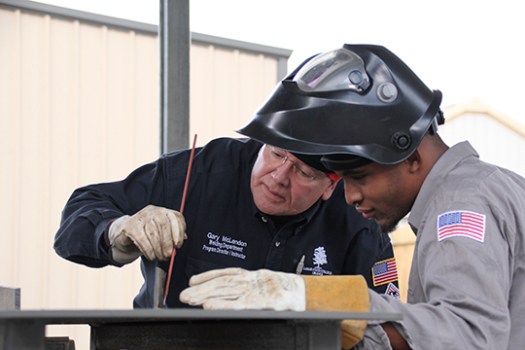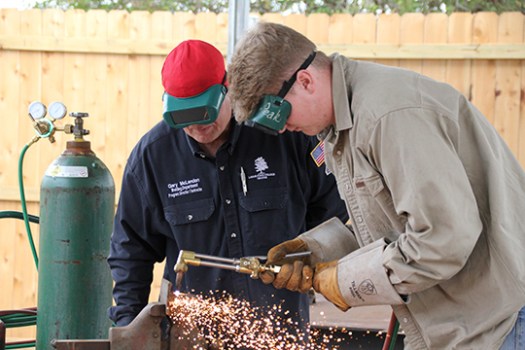BEYOND THE STORM — Meeting their needs: Lamar State steps up to support community, industries after Harvey
Published 7:01 pm Wednesday, May 2, 2018
Hurricane and Tropical Storm Harvey challenged residents throughout Southeast Texas to recover from and to remain in an area that had received historic amounts of rainfall.
Citizens, businesses and industries alike were forced to confront a reality where resources were scarce and professional aid was in high demand. Thankfully, there was an institution that not only helped others with shelter and donations, but one that already had a curriculum in place to help fill the growing demand for a qualified workforce.
Lamar State College Port Arthur went largely unaffected by floodwaters during the storm; yet, it supported residents in their times of need by providing shelter within its dormitories, historical homes and multipurpose center.
Additionally, the college’s Workforce & Continuing Education department helped — and continues to help — the community by preparing individuals for work in high-demand fields like industry and trade.
A workforce to
meet local needs
“Our mission is threefold: We want to get the unemployed profitably employed rapidly. We take the employed and raise their skills so they can be promoted and earn raises. We do it all so Texas business is the best in the United States,” Ben Stafford, dean of Workforce & Continuing Education, said.
The department’s mission rings especially important at a time when communities are rebuilding from a very damaging tropical storm.
“At the moment, we’ve got two major focuses of training,” Stafford said.
“We’ve been very active in Harvey recovery. We did quite a bit of training that would facilitate getting jobs to help people recover from Harvey.”
Lamar State has already offered resident carpentry classes so individuals could be hired as contractors to repair houses damaged by the flood, in addition to intense drywall courses to take advantage of full contractor work.
“We also have classes to give you your Texas Adjustor Insurance license,” Stafford said. “And then get you qualified in the latest software so students coming out of the class could get their license and know the most prevalent software in the field.”
Stafford said, “Our other focus is our normal focus: To meet the needs of industry in this area.”
Stafford described such courses as “fast-track,” especially the ones that earn students a Commercial Driver’s License or CDL.
“For those individuals, we offer a fast-track evening commercial driving course,” he said. “We partner with the city and the city loans us their dump trucks in the evening; so our graduates come out ready to drive.”
Lamar State also partners with the Port Arthur Independent School District, which loans them school buses in the evening on which students train.
In-demand drivers
Stafford mentioned that many students in the CDL classes are Spanish-speaking residents whose grasp of English may not be advanced; though, they are wholly committed to learning their craft and more of the language as they go along.
“They’re desperate to get a good job and to improve their socioeconomic training (so) they come with a tutor interpreter to class,” Stafford said.
He said these students get the opportunity to improve their English in class and to learn some of the technical language inherent in commercial driving at the same time they’re earning their license.
“Any evening you come over, you’ll see any big truck — school, city, rig — driving over there,” Stafford said. “We have a very large and active driving program.”
In the aftermath of Harvey, the need for trained and qualified drivers is higher than ever.
“After the storm we can’t turn out drivers quick enough,” Stafford said.
“Lowe’s, for example, they’re so busy bringing in and turning out loads that they’ve been subcontracting their work. United Rentals is the same way.”
Lamar State offers fast-track, 12-week, weeklong courses in CDL. Stafford said one could learn in 12 weeks what one would learn in two years working part-time.
According to Stafford, trucking and welding are the most popular offerings of the department, along with safety training.
“We do a lot of safety training, but trucking and welding are our key areas,” Stafford said.
Meeting industry needs
“Last year, we worked with Total and Golden Pass and Motiva to design a program: Construction Site Carpentry,” Stafford said.
The course is one of several specially made for industries in the area that would like to know exactly what they’re getting when they hire an applicant from Lamar State.
“Total is building its site cracker; Golden Pass is waiting on their LNG facility; and Motiva has two different projects. All of them will involve foundation work,” Stafford said.
Members with Lamar State met with representatives from each company and asked them what skills workers would specifically need for the jobs this foundational work would create. Accordingly, the school developed courses based on what the companies said they would need.
In constructing the required syllabus, Stafford and instructors made selections from the curriculum of the National Center for Construction Education & Research (NCCER) and tailored their courses accordingly.
“NCCER uses engineers and contractors from around the world and created a training path for each craft…” Stafford said. “So when we work with the refineries, we use NCCER curriculum. We use pieces of each to create a skillset they would need.”
For instance, Construction Site Carpentry teaches Construction Site Laborer Level 1, Scaffolding Level 1 and the NCCER Core, which includes basic safety, power tools, construction drawings and basic rigging.
“So people coming through this program get the NCCER certificates,” he said.
According to Stafford, Total estimates it would need these types of workers for 18 to 24 months for its project; Golden Pass would need people with these skillsets for a similar amount of time; and Motiva estimated it would need skilled workers for the next three years.
“The beauty of it is the college wrote the grant for the state of Texas,” Stafford said. “We have funding for up to 100 people to receive training for free.”
Funding is available for those individuals who qualify.
By the numbers
Stafford estimated the number of students who receive training from the Workforce department to range anywhere from 500 to 1,000 each year. In some years, that number could double.
In the CDL classes alone, Stafford said there are usually 30 students per class. And these are currently courses that are offered nearly every month.
“Two and a half years ago, we partnered with Motiva because they needed to re-train within their safety policies…” Stafford said. “We ran through 1,000 people in just two months then, 16-hour training every week for eight weeks.”
Stafford admitted that enrollment in their residential classes has risen sharply since Harvey, especially with interest in those wanting to attain trucking jobs.
“An estimated 90 percent of homes took water in Port Arthur,” Stafford said. “Think of any business that deals with home furnishings, home appliances and the like; they’ll be stocking and overstocking the material they sell — and that’s going to require drivers.”
Stafford remarked that it is still difficult for many stores (and residents) to get materials.
As for residential carpentry in Southeast Texas, Stafford estimates the trade will stay in demand for the next five years.
“We know it’s black humor, but the storm that left many homes damaged is also the storm that gave many people work,” Stafford said.
“People need work; and, at this point, there’s work to be had and we have the training.”
Higher education
Stafford emphasized the likelihood of students pursuing higher education once they secure a foundation for themselves with the workforce courses Lamar State offers.
“It’s a great time to start their careers,” he said. “You see many people on my side of the college who started their career in the (field) and then came back here for other training.”
Stafford said people come back to study for occupations like process operator or instrument tech. Sometimes they come back just to teach.
“I like to think we inspire people…” Stafford said. “For those already employed, we want to strengthen their skills and get them situated for promotions and raises.”
Stafford also mentioned the college’s professional development for the Port Arthur Independent School District.
“We’ll coordinate with the superintendent and he’ll share his vision of where he wants the faculty moving,” Stafford said. “And then we’ll find speakers and trainers and lead them to that vision.”
Stafford said Lamar helped Port Arthur Independent School District Superintendent Mark Porterie realize his vision for a leadership team a few years ago.
“He wanted people with a well-thought-out foundation of what kind of leader they would become,” Stafford said.
As a result, Stafford and the college picked a former U.S. Army commandant for the role. The military leader held leadership seminars for PAISD three times, something Stafford said had never been done outside the military before.
“Dr. (Betty) Reynard had a vision for a department that would be what we’re talking about…” Stafford said. “Not waiting for the industry to say, ‘We want this,’ but to foresee the need.”
Stafford said historically the college workforce training had been focused on two-year training through technical and associate programs. Now, they have programs that meet the immediate needs of both residents and industry in the area.
“In 2015, (Reynard) asked me to create this program and to position ourselves to be a proactive trainer in this area,” Stafford said. “Not to wait for after the fact, but to foresee the need and to know you’re going to expand.”
Training throughout the Triangle
Port Arthur is not the only city in the Golden Triangle with a college department dedicated to preparing individuals for work right after graduation. For in-demand trades like welding, prospective students have more than one college to look at.
Lamar State College – Orange offers a 30-hour certificate program that can be completed in two semesters. Students could expect to utilize basic math as well as blueprint reading and brazing in the program.
“The curriculum prepares students for entry-level welding positions and covers oxyacetylene, gas metal arc, shielded metal arc and gas tungsten arc welding processes,” Amy Moore, director of public information, said.
Registration is currently open for the summer and fall semesters. Financial aid and scholarships are available for those who qualify.
This story appeared in Volume 4 of The Port Arthur News Profile, April 29, 2018





